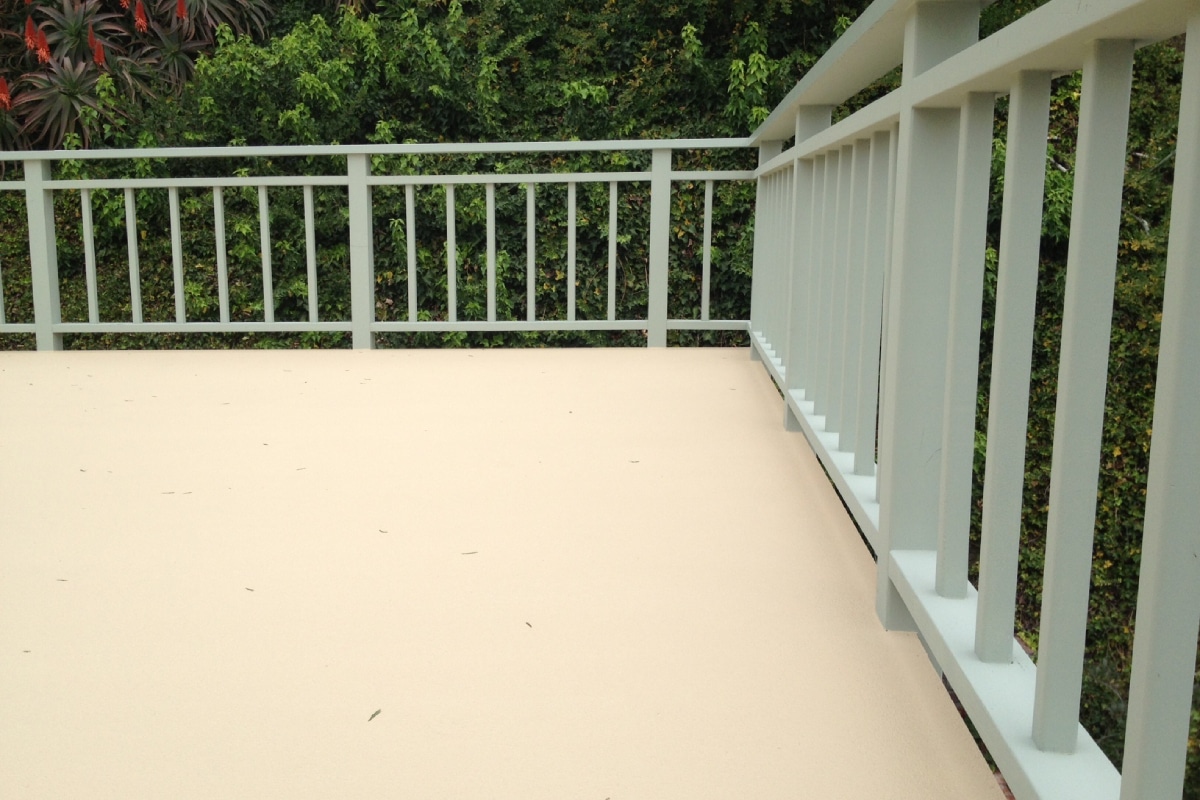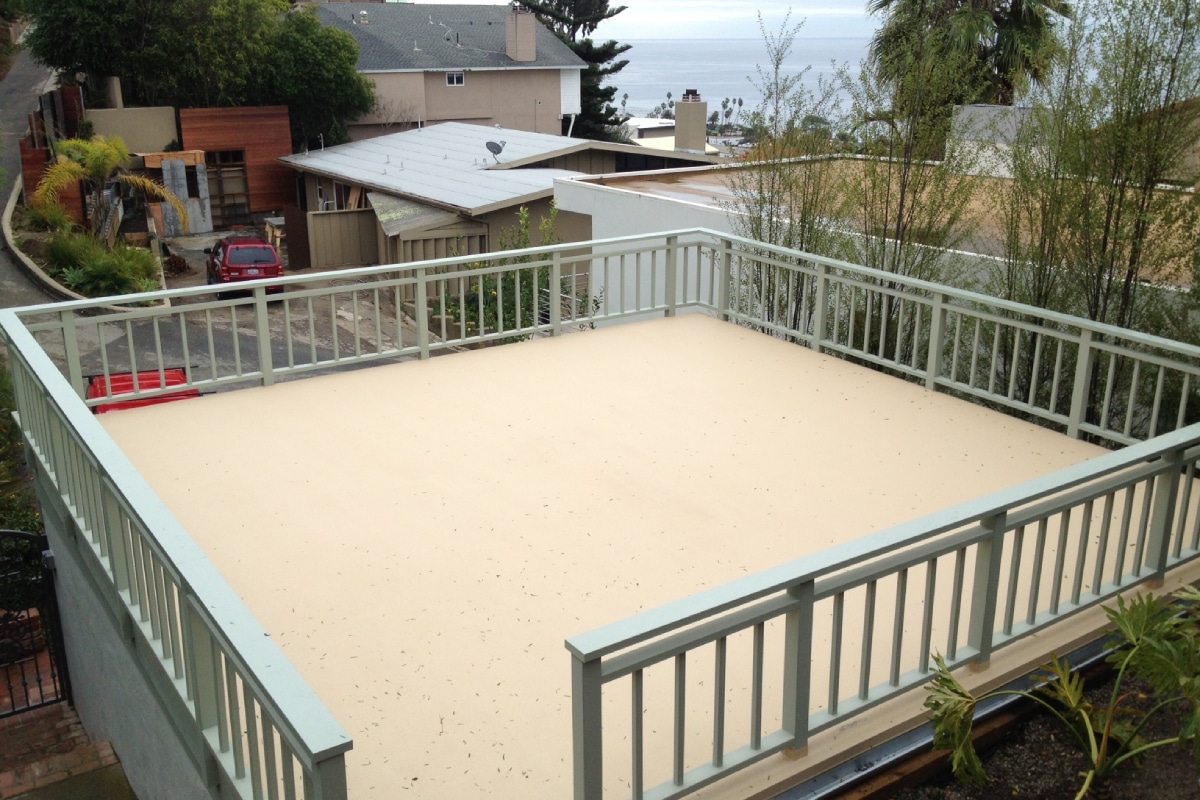Southern California’s winters might not be as harsh as those in other regions, but the rainy season can still affect your deck. Even with limited rain, prolonged moisture can lead to wear and damage over time, making winter waterproofing essential for anyone wanting to keep their deck looking its best. Follow these ten practical tips to waterproof your deck and ensure it’s ready for any weather that comes its way.
1) Inspect for Existing Damage
Before applying any waterproofing product:
- Take time to inspect the deck closely.
- Look for cracks, splits, splinters, or soft spots in the wood, which can signal rot or damage.
- Check for loose nails, screws, or bolts, as these can destabilize the deck’s structure, especially in wetter months.
Any damage can create entry points for water, so it’s essential to address issues early to prevent long-term problems.
- Pro Tip: Walk around with a flashlight during inspection to help you spot any cracks or splinters in less visible areas. Replace any rusted nails or screws with galvanized or stainless steel options to prevent future rusting.
 2) Clean the Deck Surface Thoroughly
2) Clean the Deck Surface Thoroughly
A clean surface is critical for proper waterproofing. Begin by sweeping off all loose debris, then scrub the deck with a cleaner to remove stains, algae, and dirt in the wood grain. Pay close attention to areas where leaves and dirt gather, as these can trap moisture, leading to mold and wood decay. Use a mildew remover to clean the surface effectively if your deck has mildew.
- Pro Tip: If using a power washer, keep the setting low to avoid damaging the wood fibers. Avoid harsh chemicals that might strip the wood’s natural oils for wooden decks.
3) Choose the Right Waterproofing Sealant
Selecting the right sealant can significantly improve the longevity and appearance of your deck. Different materials require specific products; for instance, oil-based sealers are best for natural wood decks, as they penetrate deeply and provide long-lasting moisture protection. Composite decks often have specific sealants recommended by manufacturers, so it’s best to consult their guidelines to avoid voiding warranties.
- Pro Tip: Look for a sealant with UV protection to help prevent fading from sun exposure, even in winter. Some sealants also come with anti-mildew properties, which can be beneficial in humid areas.
4) Apply Sealant Before the Rains Begin
Timing is essential when waterproofing. Ideally, apply the sealant in late fall or early winter before the rainy season starts. Check the weather forecast to ensure dry days, allowing the sealant ample time to bond and cure. Applying sealant on a dry, mild day ensures it penetrates the wood or composite without trapping moisture, which can lead to peeling or bubbling.
- Pro Tip: After applying the sealant, avoid using the deck for at least 24 to 48 hours to allow it to set correctly.
5) Consider Adding an Anti-Slip Coating
Rain can make deck surfaces slick, especially if they’re smooth or have a high-gloss finish. To make your deck safer, consider adding an anti-slip coating, which can be mixed into the sealant or applied as a separate layer. This is particularly beneficial in areas with high foot traffic or where moisture frequently accumulates.
- Pro Tip: If you’re concerned about aesthetics, mix a clear anti-slip additive into your chosen sealant. This way, you maintain the deck’s appearance while enhancing safety.
6) Ensure Proper Drainage with Deck Drains and Gutters
Proper drainage is critical to prevent water from pooling on the deck surface. Check any drains and gutters near or attached to the deck, and clear out debris that may have accumulated. If water is pooling in certain spots, add extra drainage options, like deck drains or water diverters, which help guide rainwater away from the deck and minimize standing water.
- Pro Tip: Observe your deck after a light rain to identify any low spots where water tends to pool. This insight will help you determine if any extra drainage is needed.
7) Use Deck Covers or Awnings for Added Protection
While a suitable sealant is essential, a deck cover or awning provides added protection from direct rainfall. This extra barrier can help reduce the moisture hitting your deck, which means less stress on the waterproofing layer. Covers are beneficial if your deck is situated directly under open skies without the natural protection of trees or an overhanging roof.
- Pro Tip: Consider investing in a retractable awning or a removable weather-resistant tarp that can be put up during heavy rain and removed on dry days to enjoy the open view.
8) Pay Attention to Deck Rails and Surrounding Structures
Waterproofing isn’t just for the deck floor. Deck rails, posts, and any surrounding structures are also exposed to rain and can suffer damage from moisture over time. Wooden rails should be treated with the same waterproofing sealant, while metal rails should be checked for rust and treated with a rust-resistant coating.
- Pro Tip: Apply sealant to deck rails in thin layers and allow each layer to dry completely before adding the next. This method ensures that moisture does not get trapped between layers.
9) Perform Routine Maintenance During the Winter
Even with waterproofing, regular maintenance throughout the season will help preserve your deck. After heavy rains, check for signs of water damage, including warping, mold growth, or peeling sealant. Clearing leaves, dirt, and debris accumulated between boards or crevices helps prevent long-term damage and keeps the surface clean.
- Pro Tip: Keep a maintenance kit handy with extra sealant, sandpaper, and patching materials to address any new issues quickly. A quick spot treatment can prevent more extensive repairs.
10) Conduct a Post-Winter Inspection to Prepare for Spring
Once winter has passed, thoroughly inspect how well your deck fared during the wet season. Look for signs of wear, fading, or damage from moisture. Spring is an ideal time to give your deck a light sanding to remove any residue, followed by a fresh layer of sealant if needed. Addressing any problems in spring ensures that your deck stays in top condition for summer and beyond.
- Pro Tip: If you notice significant wear, consider reapplying the sealant or using a refresh coat. Light sanding before sealing can help the product adhere better.
Additional Tips and Considerations
- Choose Eco-Friendly Products: To reduce environmental impact, opt for eco-friendly cleaning agents and sealants, especially if your deck is near plants or a garden.
- Schedule Annual Waterproofing: A regular waterproofing schedule (annually or biannually, depending on use) helps maintain your deck’s durability, allowing you to get the most from your investment.
- Use the Right Tools: Brushes, rollers, and even sprayers can help you apply sealants evenly and prevent over-application, which can lead to bubbling or uneven drying.
Winter deck waterproofing in Southern California doesn’t require extreme measures but calls for strategic planning and quality products. By following these tips, you’ll extend your deck’s life, keep it looking fantastic, and avoid the pitfalls of water damage while enjoying a safe, slip-resistant surface. With proper maintenance, your deck will remain a beloved outdoor space for years, easing Southern California’s mild but occasionally wet winters.
If you are looking for the best waterproof deck costing contract, Prestige Deck Coating in Southern California is here to help.
Contact Prestige Deck Coating for a quote today.

